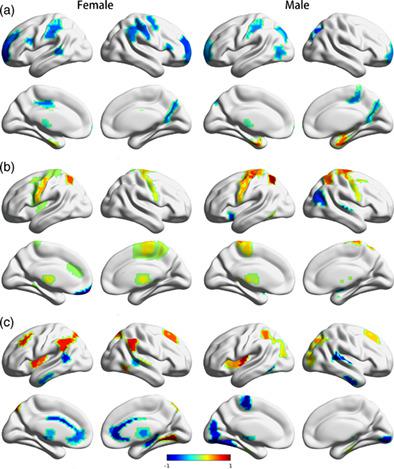当前位置:
X-MOL 学术
›
Hum. Brain Mapp.
›
论文详情
Our official English website, www.x-mol.net, welcomes your feedback! (Note: you will need to create a separate account there.)
Predicting brain age during typical and atypical development based on structural and functional neuroimaging
Human Brain Mapping ( IF 4.8 ) Pub Date : 2021-09-14 , DOI: 10.1002/hbm.25660 Qi Wang 1, 2 , Ke Hu 1, 2 , Meng Wang 1, 2 , Yuxin Zhao 1, 2 , Yong Liu 3 , Lingzhong Fan 1, 2, 4 , Bing Liu 5, 6
Human Brain Mapping ( IF 4.8 ) Pub Date : 2021-09-14 , DOI: 10.1002/hbm.25660 Qi Wang 1, 2 , Ke Hu 1, 2 , Meng Wang 1, 2 , Yuxin Zhao 1, 2 , Yong Liu 3 , Lingzhong Fan 1, 2, 4 , Bing Liu 5, 6
Affiliation

|
Exploring typical and atypical brain developmental trajectories is very important for understanding the normal pace of brain development and the mechanisms by which mental disorders deviate from normal development. A precise and sex-specific brain age prediction model is desirable for investigating the systematic deviation and individual heterogeneity of disorders associated with atypical brain development, such as autism spectrum disorders. In this study, we used partial least squares regression and the stacking algorithm to establish a sex-specific brain age prediction model based on T1-weighted structural magnetic resonance imaging and resting-state functional magnetic resonance imaging. The model showed good generalization and high robustness on four independent datasets with different ethnic information and age ranges. A predictor weights analysis showed the differences and similarities in changes in structure and function during brain development. At the group level, the brain age gap estimation for autistic patients was significantly smaller than that for healthy controls in both the ABIDE dataset and the healthy brain network dataset, which suggested that autistic patients as a whole exhibited the characteristics of delayed development. However, within the ABIDE dataset, the premature development group had significantly higher Autism Diagnostic Observation Schedule (ADOS) scores than those of the delayed development group, implying that individuals with premature development had greater severity. Using these findings, we built an accurate typical brain development trajectory and developed a method of atypical trajectory analysis that considers sex differences and individual heterogeneity. This strategy may provide valuable clues for understanding the relationship between brain development and mental disorders.
中文翻译:

基于结构和功能神经影像学预测典型和非典型发育过程中的大脑年龄
探索典型和非典型的大脑发育轨迹对于了解大脑的正常发育速度以及精神障碍偏离正常发育的机制非常重要。对于研究与非典型大脑发育相关的疾病(例如自闭症谱系障碍)的系统偏差和个体异质性,需要一个精确且具有性别特异性的脑年龄预测模型。在本研究中,我们使用偏最小二乘回归和stacking算法建立了基于T1加权结构磁共振成像和静息态功能磁共振成像的性别特异性脑年龄预测模型。该模型在具有不同种族信息和年龄范围的四个独立数据集上显示出良好的泛化性和高稳健性。预测权重分析显示了大脑发育过程中结构和功能变化的差异和相似之处。在组水平上,ABIDE 数据集和健康大脑网络数据集中自闭症患者的大脑年龄差距估计明显小于健康对照组,这表明自闭症患者整体表现出发育迟缓的特征。然而,在 ABIDE 数据集中,过早发育组的自闭症诊断观察计划 (ADOS) 分数明显高于发育迟缓组,这意味着过早发育组的严重程度更高。利用这些发现,我们建立了一个准确的典型大脑发育轨迹,并开发了一种考虑性别差异和个体异质性的非典型轨迹分析方法。这一策略可能为理解大脑发育与精神障碍之间的关系提供有价值的线索。
更新日期:2021-11-17
中文翻译:

基于结构和功能神经影像学预测典型和非典型发育过程中的大脑年龄
探索典型和非典型的大脑发育轨迹对于了解大脑的正常发育速度以及精神障碍偏离正常发育的机制非常重要。对于研究与非典型大脑发育相关的疾病(例如自闭症谱系障碍)的系统偏差和个体异质性,需要一个精确且具有性别特异性的脑年龄预测模型。在本研究中,我们使用偏最小二乘回归和stacking算法建立了基于T1加权结构磁共振成像和静息态功能磁共振成像的性别特异性脑年龄预测模型。该模型在具有不同种族信息和年龄范围的四个独立数据集上显示出良好的泛化性和高稳健性。预测权重分析显示了大脑发育过程中结构和功能变化的差异和相似之处。在组水平上,ABIDE 数据集和健康大脑网络数据集中自闭症患者的大脑年龄差距估计明显小于健康对照组,这表明自闭症患者整体表现出发育迟缓的特征。然而,在 ABIDE 数据集中,过早发育组的自闭症诊断观察计划 (ADOS) 分数明显高于发育迟缓组,这意味着过早发育组的严重程度更高。利用这些发现,我们建立了一个准确的典型大脑发育轨迹,并开发了一种考虑性别差异和个体异质性的非典型轨迹分析方法。这一策略可能为理解大脑发育与精神障碍之间的关系提供有价值的线索。


























 京公网安备 11010802027423号
京公网安备 11010802027423号